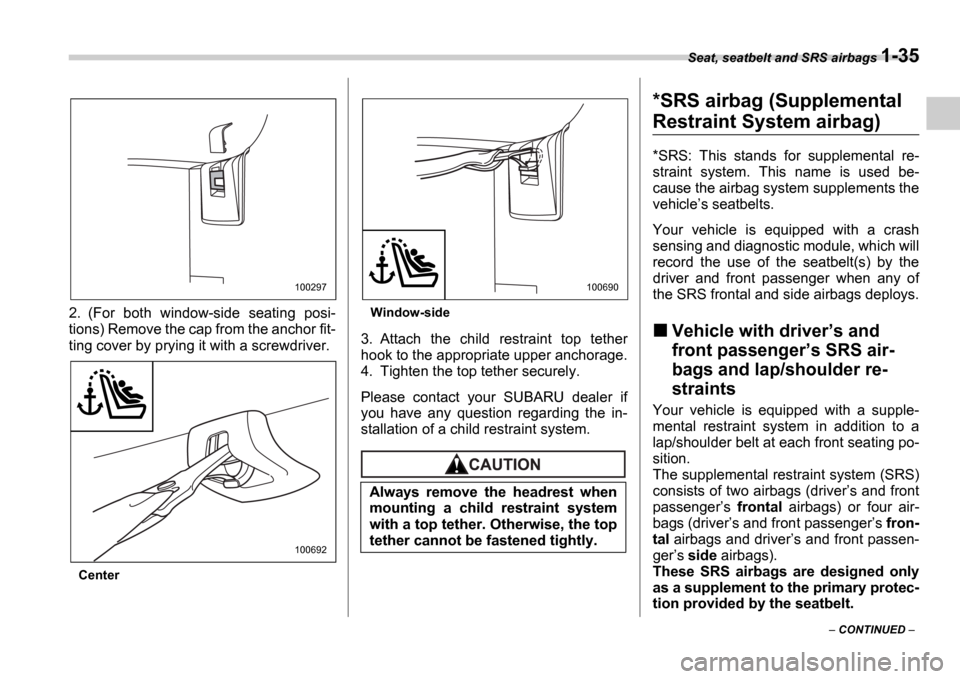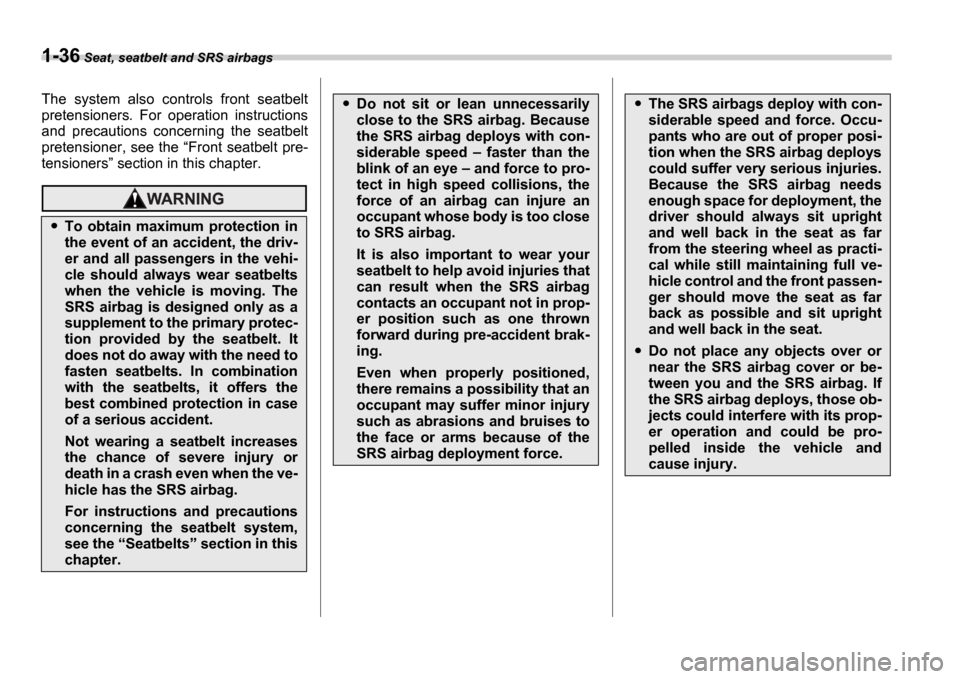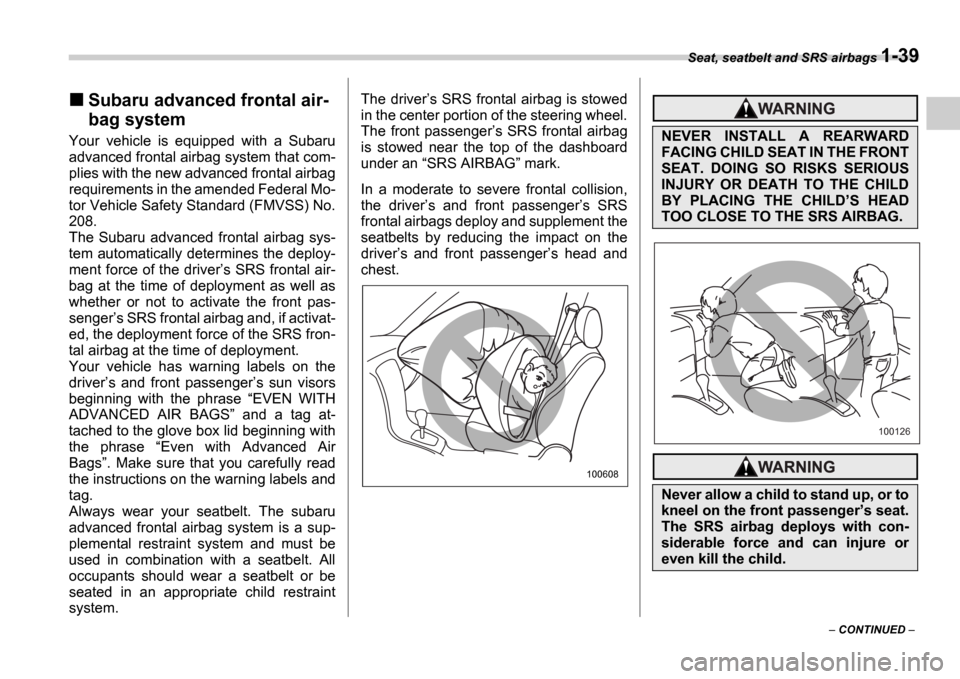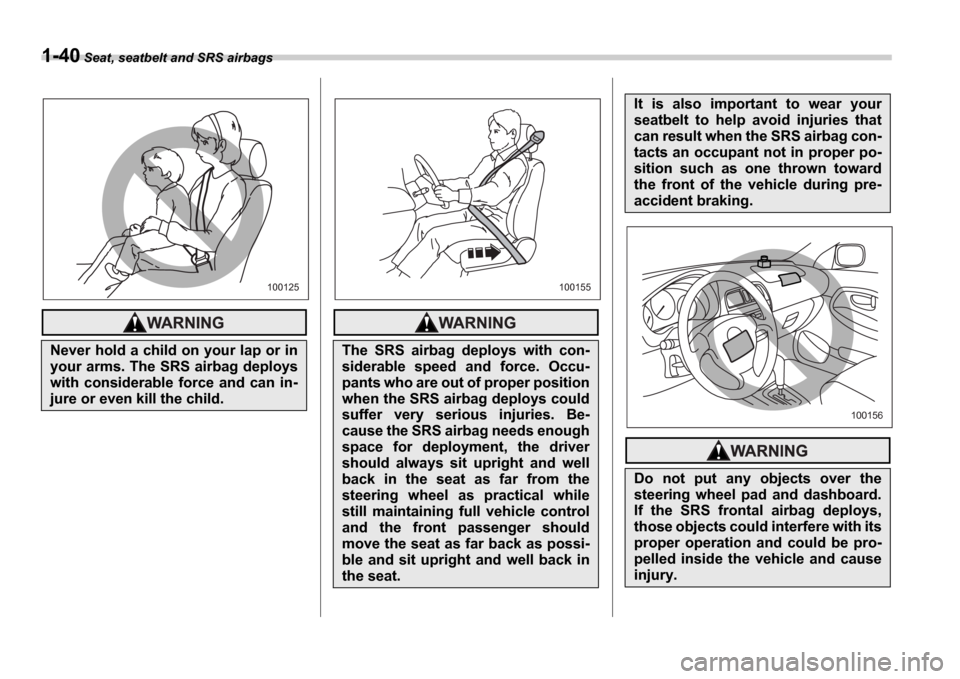2006 SUBARU IMPREZA airbag
[x] Cancel search: airbagPage 61 of 365

1-34 Seat, seatbelt and SRS airbags
Three upper anchorages are installed on
the rear shelf behind the rear seat.
Wagon
1) For left seat
2) For center seat
3) For right seat
There is an anchorage for the center seat-
ing position at the rear edge of the roof,
and anchorages for each of the two win-
dow-side seating positions on the rear
wall of the cargo area.
To hook the top tether
Sedan
1. Attach the child restraint top tether
hook to the appropriate upper anchorage.
2. Tighten the top tether securely.
Please contact your SUBARU dealer if
you have any question regarding the in-
stallation of a child restraint system.
Wagon
1. Remove the headrest at the window-
side seating position where the child re-
straint system has been installed with the
lower anchorages or seatbelt; lift up the
headrest while pressing the release but-
ton. Store the headrest in the cargo area.
Avoid placing the headrest in the passen-
ger compartment to prevent it from being
thrown around in the passenger compart-
ment in a sudden stop or a sharp turn.
2 1 3
100696
100689
100151
Page 62 of 365

Seat, seatbelt and SRS airbags 1-35
CONTINUED
2. (For both window-side seating posi-
tions) Remove the cap from the anchor fit-
ting cover by prying it with a screwdriver.
Center
Window-side
3. Attach the child restraint top tether
hook to the appropriate upper anchorage.
4. Tighten the top tether securely.
Please contact your SUBARU dealer if
you have any question regarding the in-
stallation of a child restraint system.
*SRS airbag (Supplemental
Restraint System airbag)
*SRS: This stands for supplemental re-
straint system. This name is used be-
cause the airbag system supplements the
vehicle
s seatbelts.
Your vehicle is equipped with a crash
sensing and diagnostic module, which will
record the use of the seatbelt(s) by the
driver and front passenger when any of
the SRS frontal and side airbags deploys.
Vehicle with driver s and
front passenger s SRS air-
bags and lap/shoulder re-
straints
Your vehicle is equipped with a supple-
mental restraint system in addition to a
lap/shoulder belt at each front seating po-
sition.
The supplemental restraint system (SRS)
consists of two airbags (driver s and front
passenger s frontal airbags) or four air-
bags (driver s and front passenger s fron-
tal airbags and driver s and front passen-
ger s side airbags).
These SRS airbags are designed only
as a supplement to the primary protec-
tion provided by the seatbelt.
100297
100692
Always remove the headrest when
mounting a child restraint system
with a top tether. Otherwise, the top
tether cannot be fastened tightly.
100690
Page 63 of 365

1-36 Seat, seatbelt and SRS airbags
The system also controls front seatbelt
pretensioners. For operation instructions
and precautions concerning the seatbelt
pretensioner, see the Front seatbelt pre-
tensioners section in this chapter.
To obtain maximum protection in
the event of an accident, the driv-
er and all passengers in the vehi-
cle should always wear seatbelts
when the vehicle is moving. The
SRS airbag is designed only as a
supplement to the primary protec-
tion provided by the seatbelt. It
does not do away with the need to
fasten seatbelts. In combination
with the seatbelts, it offers the
best combined protection in case
of a serious accident.
Not wearing a seatbelt increases
the chance of severe injury or
death in a crash even when the ve-
hicle has the SRS airbag.
For instructions and precautions
concerning the seatbelt system,
see the Seatbelts section in this
chapter.
Do not sit or lean unnecessarily
close to the SRS airbag. Because
the SRS airbag deploys with con-
siderable speed faster than the
blink of an eye and force to pro-
tect in high speed collisions, the
force of an airbag can injure an
occupant whose body is too close
to SRS airbag.
It is also important to wear your
seatbelt to help avoid injuries that
can result when the SRS airbag
contacts an occupant not in prop-
er position such as one thrown
forward during pre-accident brak-
ing.
Even when properly positioned,
there remains a possibility that an
occupant may suffer minor injury
such as abrasions and bruises to
the face or arms because of the
SRS airbag deployment force.
The SRS airbags deploy with con-
siderable speed and force. Occu-
pants who are out of proper posi-
tion when the SRS airbag deploys
could suffer very serious injuries.
Because the SRS airbag needs
enough space for deployment, the
driver should always sit upright
and well back in the seat as far
from the steering wheel as practi-
cal while still maintaining full ve-
hicle control and the front passen-
ger should move the seat as far
back as possible and sit upright
and well back in the seat.
Do not place any objects over or
near the SRS airbag cover or be-
tween you and the SRS airbag. If
the SRS airbag deploys, those ob-
jects could interfere with its prop-
er operation and could be pro-
pelled inside the vehicle and
cause injury.
Page 64 of 365

Seat, seatbelt and SRS airbags 1-37
CONTINUED
NOTE
When you sell your vehicle, we urge
you to explain to the buyer that it is
equipped with SRS airbags by alerting
him or her to the applicable section in
this owners manual.
Put children aged 12 and under in
the rear seat properly restrained
at all times. The SRS airbag de-
ploys with considerable speed
and force and can injure or even
kill children, especially if they are
12 years of age and under and are
not restrained or improperly re-
strained. Because children are
lighter and weaker than adults,
their risk of being injured from de-
ployment is greater.
100082
For that reason, we strongly rec-
ommend that ALL children (in-
cluding those in child seats and
those that have outgrown child re-
straint devices) sit in the REAR
seat properly restrained at all
times in a child restraint device or
in a seatbelt, whichever is appro-
priate for the child s age, height
and weight.
Secure ALL types of child re-
straint devices (including forward
facing child seats) in the REAR
seats at all times.
According to accident statistics,
children are safer when properly
restrained in the rear seating posi-
tions than in the front seating po-
sitions.
For instructions and precautions
concerning the child restraint sys-
tem, see the Child restraint sys-
tems section in this chapter.
NEVER INSTALL A REARWARD
FACING CHILD SEAT IN THE
FRONT SEAT. DOING SO RISKS
SERIOUS INJURY OR DEATH TO
THE CHILD BY PLACING THE
CHILD S HEAD TOO CLOSE TO
THE SRS AIRBAG.
Never allow a child to stand up, or
to kneel on the front passenger s
seat, or never hold a child on your
lap or in your arms. The SRS air-
bag deploys with considerable
force and can injure or even kill
the child.
When the SRS airbag deploys,
some smoke will be released. This
smoke could cause breathing
problems for people with a history
of asthma or other breathing trou-
ble. If you or your passengers
have breathing problems after
SRS airbag deploys, get fresh air
promptly.
A deploying SRS airbag releases
hot gas. Occupants could get
burned if they come into direct
contact with the hot gas.
Page 65 of 365

1-38 Seat, seatbelt and SRS airbags
Components
1
2
3
4
5
6
14 15
2019
8
11 17
18
9
7 10
12
16
13
100701 1) Airbag control module (including impact
sensors)
2) Frontal airbag module (driver s side)
3) Frontal airbag module (front passen-
gers side)
4) Front sub sensor (left-hand side)
5) Front sub sensor (right-hand side)
6) Side airbag module (driver s side)
7) Side airbag module (front passenger s
side)
8) Side airbag sensor (center pillar left-
hand side)
9) Side airbag sensor (center pillar right- hand side)
10)Airbag wiring (yellow)
11)Seatbelt pretensioner (driver s side)
12) Seatbelt pretensioner (front passenger s
side)
13)Seatbelt buckle switch (front passen- gers side)
14)Seatbelt buckle switch (driver s side)
15) Driver s seat position sensor
16)Front passenger s seatbelt tension sen-
sor
17)Front passenger s occupant detection
system weight sensor
18)Front passenger s occupant detection
control module
19)Front passenger s frontal airbag ON and
OFF indicator
20)SRS airbag system warning light
Page 66 of 365

Seat, seatbelt and SRS airbags 1-39
CONTINUED
Subaru advanced frontal air-
bag system
Your vehicle is equipped with a Subaru
advanced frontal airbag system that com-
plies with the new advanced frontal airbag
requirements in the amended Federal Mo-
tor Vehicle Safety Standard (FMVSS) No.
208.
The Subaru advanced frontal airbag sys-
tem automatically determines the deploy-
ment force of the driver s SRS frontal air-
bag at the time of deployment as well as
whether or not to activate the front pas-
senger s SRS frontal airbag and, if activat-
ed, the deployment force of the SRS fron-
tal airbag at the time of deployment.
Your vehicle has warning labels on the
driver s and front passenger s sun visors
beginning with the phrase EVEN WITH
ADVANCED AIR BAGS and a tag at-
tached to the glove box lid beginning with
the phrase Even with Advanced Air
Bags . Make sure that you carefully read
the instructions on the warning labels and
tag.
Always wear your seatbelt. The subaru
advanced frontal airbag system is a sup-
plemental restraint system and must be
used in combination with a seatbelt. All
occupants should wear a seatbelt or be
seated in an appropriate child restraint
system. The driver
s SRS frontal airbag is stowed
in the center portion of the steering wheel.
The front passenger s SRS frontal airbag
is stowed near the top of the dashboard
under an SRS AIRBAG mark.
In a moderate to severe frontal collision,
the driver s and front passenger s SRS
frontal airbags deploy and supplement the
seatbelts by reducing the impact on the
driver s and front passenger s head and
chest.
100608
NEVER INSTALL A REARWARD
FACING CHILD SEAT IN THE FRONT
SEAT. DOING SO RISKS SERIOUS
INJURY OR DEATH TO THE CHILD
BY PLACING THE CHILD S HEAD
TOO CLOSE TO THE SRS AIRBAG.
Never allow a child to stand up, or to
kneel on the front passenger s seat.
The SRS airbag deploys with con-
siderable force and can injure or
even kill the child.
100126
Page 67 of 365

1-40 Seat, seatbelt and SRS airbags
Never hold a child on your lap or in
your arms. The SRS airbag deploys
with considerable force and can in-
jure or even kill the child.
100125
The SRS airbag deploys with con-
siderable speed and force. Occu-
pants who are out of proper position
when the SRS airbag deploys could
suffer very serious injuries. Be-
cause the SRS airbag needs enough
space for deployment, the driver
should always sit upright and well
back in the seat as far from the
steering wheel as practical while
still maintaining full vehicle control
and the front passenger should
move the seat as far back as possi-
ble and sit upright and well back in
the seat.
100155
It is also important to wear your
seatbelt to help avoid injuries that
can result when the SRS airbag con-
tacts an occupant not in proper po-
sition such as one thrown toward
the front of the vehicle during pre-
accident braking.
Do not put any objects over the
steering wheel pad and dashboard.
If the SRS frontal airbag deploys,
those objects could interfere with its
proper operation and could be pro-
pelled inside the vehicle and cause
injury.
100156
Page 68 of 365

Seat, seatbelt and SRS airbags 1-41
CONTINUED
Drivers SRS frontal airbag
The driver s SRS frontal airbag uses a
dual stage inflator. The inflator operates in
different ways depending on the severity
of impact, backward-forward adjustment
of the driver s seat position and whether or
not he/she is wearing the seatbelt.
The backward-forward adjustment of the
driver s seat position is monitored by the
driver s seat position sensor under the driver
s seat.
Whether or not the driver is wearing the
seatbelt is monitored by the seatbelt buck-
le switch.
Observe the following precautions. Failure
to do so may cause the seatbelt buckle
switch and/or the seat position sensor to
malfunction, preventing the Subaru ad-
vanced frontal airbag system from func-
tioning correctly or causing the system to
fail.
Do not place articles/metal objects or in-
stall any accessory other than a genuine
SUBARU accessory under the driver s
seat. Do not allow the rear seat occupant
to kick the driver s seat or push up its bot-
tom surface with his/her feet.
Do not place a magnet near the seatbelt
buckle or under the driver s seat.
If the seatbelt buckle switch and/or the
driver s seat position sensor have failed,
the SRS airbag system warning light will il-
luminate. Although the driver s SRS fron-
tal airbag can deploy regardless of the
backward-forward adjustment of the driv-
er s seat position even when the warning
light is on, have the system inspected by
your SUBARU dealer immediately if the
SRS airbag system warning light comes
on.
NOTE
The driver s SRS side airbag and seat-
belt pretensioner are not controlled by
the Subaru advanced frontal airbag
system.
Front passenger s SRS frontal air-
bag
The front passenger s SRS frontal airbag
uses a dual stage inflator. The inflator op-
erates in different ways depending on the
severity of impact.
The total load on the seat is monitored by
the occupant detection system s weight
sensor located under the seat.
The system has another sensor that mon-
itors the tension of the front passenger
seatbelt. Using the total seat load and
seatbelt tension data from the sensors,
the occupant detection system deter-
mines whether the front passenger s SRS
frontal airbag should or should not be in-
flated.
The occupant detection system may not
inflate the front passenger s SRS frontal
airbag even when the driver s SRS frontal
airbag deploys. This is normal.
Observe the following precautions. Failure
to do so may prevent the Subaru ad-
vanced frontal airbag system from func-
tioning correctly or cause the system to
fail.
Do not attach accessories to the
windshield, or fit an extra-wide mir-
ror over the rear view mirror. If the
SRS airbag deploys, those objects
could become projectiles that could
seriously injure vehicle occupants.
100157